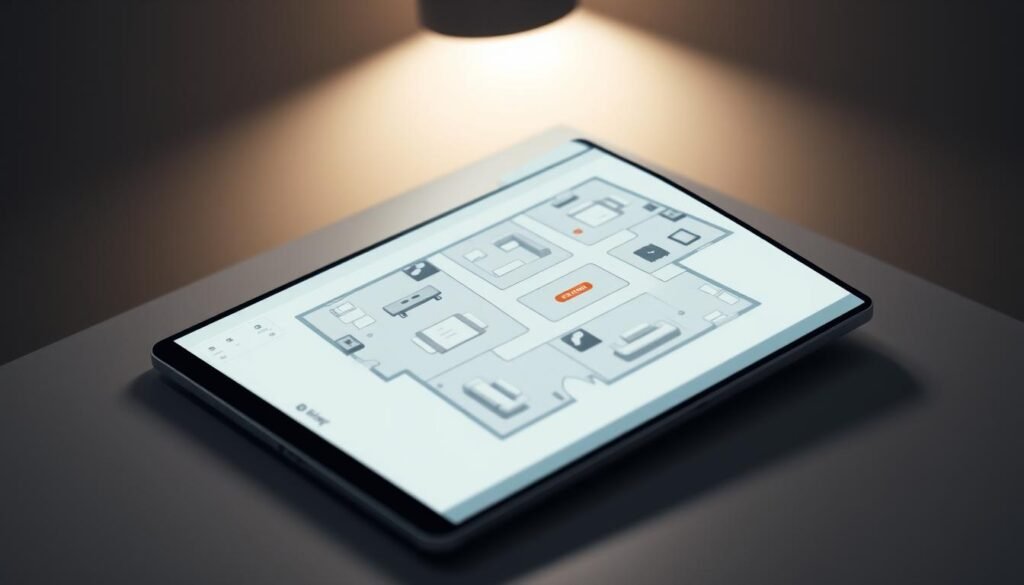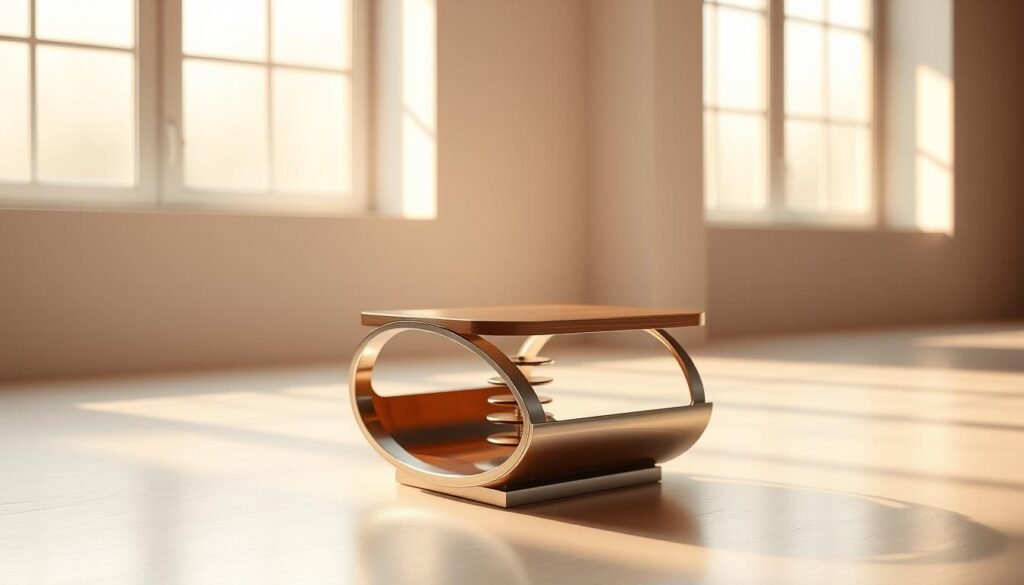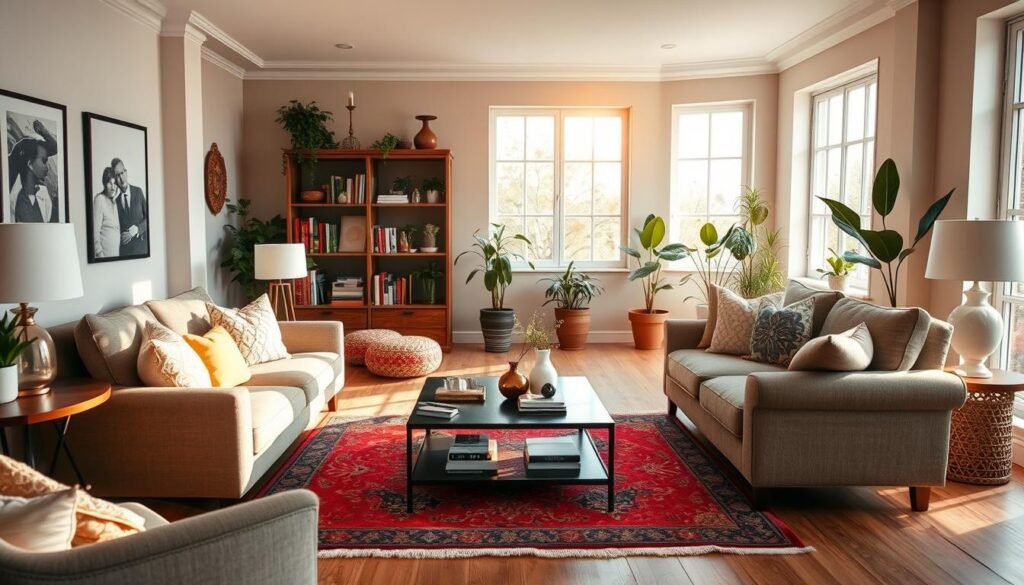Starting a new design project can feel overwhelming. Where do you focus first? The answer lies in creating a clear plan that aligns with your vision. Breaking the process into smaller steps helps avoid decision fatigue and keeps your goals achievable.
Begin by assessing the space’s purpose. Is it a cozy living area or a functional home office? This clarity shapes your style choices and ensures every decor element serves a purpose. Budget-friendly ideas like repurposing furniture or DIY accents often spark the most creative solutions.
Your personal taste should guide the design. Whether you prefer modern minimalism or eclectic charm, prioritize pieces that reflect your personality. Remember: great style isn’t about perfection—it’s about creating harmony between function and aesthetics.
Key Takeaways
- Start with a systematic approach to simplify decision-making
- Define the room’s primary function before selecting decor
- Use budget constraints to fuel creative problem-solving
- Adapt designs to suit your home’s unique layout
- Blend personal style with practical needs for best results
Kickstarting Your Design Journey with a Mood Board
Your design journey begins before you buy a single item. Crafting a mood board helps transform scattered ideas into a clear vision. This visual tool acts as your roadmap, ensuring every choice supports your ultimate goals.
Gathering Visual Inspirations
Start by exploring platforms like Pinterest. Collect 40-50 images of spaces, furniture, and color schemes that catch your eye. Focus on clean shots with plain backgrounds to evaluate pieces objectively.
Ask key questions during this phase: What mood should this area evoke? How will the space be used daily? These answers shape your selections and prevent costly mismatches.
Identifying Your Personal Style
After gathering inspiration, look for patterns. Do mid-century shapes dominate your pins? Are earthy colors recurring? These clues reveal your authentic taste, which might surprise you.
| Element | Common Themes | Action Steps |
|---|---|---|
| Color Schemes | 3+ repeating hues | Create swatch palette |
| Furniture Styles | Consistent era or material | Note dominant features |
| Textures | Repeated finishes (matte, woven) | Source samples |
Build a refined board mixing existing items with new finds. This shows how everything works together, creating that polished look you want for your house.
Budgeting for decorating a room Project
Smart financial planning transforms design dreams into achievable realities. Begin by listing every expense—from materials to labor—in a spreadsheet. This approach helps visualize where your money flows and prevents surprises later.
Setting Priorities and Allocating Costs
Divide your list into three categories: essentials, upgrades, and future wishes. Essentials might include seating or lighting, while upgrades could be premium finishes. Always request three quotes for pro services—you’ll often find price differences up to 30% for similar work.
For kitchen updates or structural changes, set aside 20% extra for unexpected issues. Smaller refreshes need a 10% buffer. Track sales on furniture and decor—timing purchases around holiday weekends saves significant cash.
Avoiding Budget Overruns
Stick to your plan like glue. Mid-project changes add fees and delays. If you spot a must-have item exceeding your limit, pause and reconsider: Can you DIY part of it? Swap pricier materials for lookalikes?
One clever way to stretch funds: focus on high-impact elements first. A statement light fixture or fresh wall color often delivers more wow-per-dollar than expensive furniture.
Crafting a Scaled Room Layout and Floor Planner
Visualizing your space accurately prevents buyer’s remorse and maximizes functionality. A detailed plan acts as your blueprint, helping you avoid purchasing items that clash with your floor dimensions or lifestyle needs.

Measuring Your Space Accurately
Grab a tape measure and note every structural detail. Record wall lengths, window heights, and outlet positions. Permanent features like radiators or built-in shelves dictate where furniture can realistically go.
Mark these measurements on graph paper using a 1:12 scale (1 inch = 1 foot). This old-school method works great for small areas. For larger spaces, consider digital tools to save time.
Utilizing Free Floor Planner Tools
Platforms like Roomstyler.com turn measurements into interactive 3D models. Navigate to their 3D planner tool and input your dimensions. Drag-and-drop furniture pieces to experiment with layouts virtually.
| Method | Tools Needed | Benefits | Best For |
|---|---|---|---|
| Traditional | Graph paper, ruler | Tactile experience | Single-room projects |
| Digital | Room planner apps | 3D previews | Multi-space designs |
Once your plan feels right, test it physically. Use blue painter’s tape to outline floor placements. Walk through these mockups to check traffic flow and comfort.
Remember: leave 18 inches between seating and coffee tables. This ensures easy movement while keeping essentials within reach.
Incorporating Inspiration with a ‘Springboard’ Object
Every great design needs a starting point that sparks creativity. A springboard object acts like your project’s North Star, guiding choices while leaving room for spontaneity. This anchor piece could be a rug with vibrant colors or a family heirloom that tells your story.

Selecting the Perfect Focal Piece
Choose items that make your heart skip a beat. A sunset photograph might inspire wall color choices, while a geometric lamp could dictate angular furniture shapes. Trust your gut—authenticity creates cohesive spaces.
| Object Type | Design Influence | Implementation Tip |
|---|---|---|
| Artwork | Sets primary colors | Pull 2-3 hues for accents |
| Vintage Chair | Dictates style era | Mix with modern textures |
| Patterned Rug | Establishes visual rhythm | Repeat shapes in decor |
Integrating New Ideas with What You Own
Test your springboard against existing furniture. Does that abstract painting clash with your striped sofa? Try moving pieces to new spots before buying replacements. Sometimes fresh arrangements solve design dilemmas.
For paint color decisions, sample swatches next to your inspiration item at different daylight hours. Notice how morning sun changes a cream tone versus evening lamplight.
| Challenge | Solution | Outcome |
|---|---|---|
| Mismatched eras | Add transitional lighting | Cohesive look |
| Clashing patterns | Use solid-color pillows | Visual balance |
| Limited space | Multi-functional pieces | Streamlined flow |
Remember: Your springboard should fuel ideas, not limit them. If a coral accent from your rug feels overwhelming, try softer peach tones. The goal is harmony, not perfect replication.
Choosing Foundation Furniture for Flexibility and Style
Smart furniture choices lay the groundwork for spaces that adapt as your life evolves. Start with pieces offering timeless appeal and practical durability – these become the backbone of your design.
Neutral Pieces for Long-Term Appeal
A sofa in warm gray or cream works with coastal vibes today and boho accents tomorrow. Pair it with a simple coffee table featuring clean lines. These anchors let you refresh your style through seasonal pillows or bold artwork.
Classic armchairs in natural linen outlast trends better than bold patterns. Look for sturdy frames with removable cushions – they’ll survive multiple redecoration cycles.
Smart Selections for Kid- and Pet-Friendly Living
Aniline-dyed leather resists juice spills better than porous fabrics. Crypton performance velvet handles muddy paws while feeling luxe. Consider washable slipcovers for dining chairs – they’re lifesavers during spaghetti nights.
| Material | Best For | Care Tip |
|---|---|---|
| Aniline Leather | High-traffic areas | Blot spills immediately |
| Sunbrella Fabric | Outdoor/indoor use | Machine wash cold |
| Performance Velvet | Formal spaces | Vacuum weekly |
Remember: Furniture shouldn’t feel precious. Choose pieces that welcome movie nights and impromptu dance parties – that’s where real memories happen.
Picking the Ideal Paint Palette to Enhance Your Space
Wall colors transform spaces more dramatically than any other design choice. Your mood board and springboard object now become essential tools for navigating this critical phase. This decision impacts how light dances through your interior and how furnishings command attention.
Coordinating Colors with Your Mood Board
Revisit your collected inspirations to identify dominant hues. Does that sunset photo lean peach or terracotta? Your springboard rug’s accent threads might reveal your ideal accent shade. Create cohesion by selecting one primary paint color and two supporting tones.
| Color Role | Application | Pro Tip |
|---|---|---|
| Primary | Walls | 60% of visual space |
| Secondary | Trim/Doors | Contrast by 3 LRV points |
| Accent | Niche areas | Use in trios for balance |
Testing and Refining Paint Samples
Paint 2×2 foot swatches on multiple walls. Observe how morning sun intensifies blues while evening lamps warm grays. Live with these test patches through three daylight cycles before deciding.
For open-concept areas, paint sample boards you can move between zones. This reveals how colors transition between connected spaces. Always use original paint brands for tests – store-mixed duplicates often differ.
Remember: The perfect color should complement your happiest decor piece. If that heirloom chair pops against slate walls, you’ve found your match. Trust the process – great spaces evolve through thoughtful experimentation.
Conclusion
Transforming your home into a reflection of your personality becomes effortless with strategic planning. A systematic approach lets you balance creativity with practicality, turning even complex renovation projects into achievable milestones.
Your journey begins by understanding the space’s purpose – whether it’s a lively kitchen or serene bedroom. This clarity informs smart material choices and layout solutions that enhance daily life. Budget-friendly ideas like seasonal sales or multi-functional furniture keep costs manageable without sacrificing character.
Remember: great design evolves through experimentation. That bold rug anchoring your living area? It might inspire window treatments you’d never considered. Foundational pieces in neutral tones adapt as your style shifts over time, proving good planning outlasts fleeting trends.
Embrace the process as an ongoing conversation between your vision and the materials shaping it. When challenges arise – and they will – return to your original mood board. These guideposts help maintain focus while allowing room for joyful surprises.
Your newly curated environment should feel uniquely yours. Whether hosting dinners or enjoying quiet mornings, every thoughtful choice contributes to a home that works as beautifully as it looks.

